Welcome to my green thumb journey as I delve into the breathtaking beauty of the orange torch ginger plant, a tropical flower known as Alpinia purpurata in the Zingiberaceae family. This vibrant plant, with its stunning cone-shaped flowers and drooping bracts, adds a touch of tropical elegance to any garden or landscape.
- The orange torch ginger plant, scientifically known as Alpinia purpurata, belongs to the Zingiberaceae family and is a tropical flower.
- It thrives in a tropical environment with full to partial sun and well-drained, moist soil.
- Propagation can be done through division or seeds, allowing for the cultivation of various color varieties.
- Pruning is minimal, and the plant can be grown both indoors and outdoors, adding beauty to any space.
- Proper watering is crucial, as overwatering or underwatering can lead to leaf discoloration and damage.
Join me as we explore the growth conditions, propagation methods, care tips, and the ornamental appeal of the orange torch ginger plant. You’ll discover why this tropical flower is a must-have for gardening enthusiasts and landscape designers alike.
Torch Ginger Plant Overview
The torch ginger plant, also known as ginger lilies, is a perennial tropical plant in the ginger family, renowned for its stunning blooms and lush foliage. This plant, scientifically known as Etlingera elatior, is a true showstopper with its vibrant colors and cone-shaped flowers. Growing up to 15 feet tall and spreading in clumps, it adds a touch of tropical beauty to any garden or landscape.
The torch ginger plant features large, drooping bracts that surround its flowers, creating a visually striking display. These bracts come in a range of colors, including red, pink, and white. The flowers bloom throughout the year, providing continuous beauty and interest. The lush foliage enhances the overall appeal of the plant, with its tall, erect stems and broad leaves.
To thrive, the torch ginger plant prefers full to partial sun and well-drained, moist soil. It requires a tropical environment with plenty of water, heat, and humidity. When it comes to propagation, the plant can be easily multiplied through both division and seeds. With its various varieties and adaptability to both indoor and outdoor settings, the torch ginger plant offers versatility and beauty to gardening enthusiasts.
| Common Name | Scientific Name | Family |
|---|---|---|
| Torch Ginger | Etlingera elatior | Zingiberaceae |
Growth Conditions for Orange Torch Ginger Plant
To thrive and show off its vibrant hues, the orange torch ginger plant requires a tropical environment with well-drained soil and either full or partial sun exposure. This stunning tropical flower, scientifically known as Alpinia purpurata and belonging to the Zingiberaceae family, thrives in regions with high heat and humidity. Plant enthusiasts worldwide adore the orange torch ginger plant for its striking beauty and ability to brighten up any garden or indoor space.
When it comes to soil preferences, the orange torch ginger plant thrives in well-drained soil. It is essential to ensure that the soil is not too compact and allows excess water to drain away effectively. This helps prevent waterlogging, which can potentially harm the plant’s roots. Additionally, providing the plant with adequate sunlight is crucial for its healthy growth. While the orange torch ginger plant prefers full sun exposure, it can also tolerate partial sun, making it versatile in various garden settings.
Creating a tropical environment is key to the successful cultivation of the orange torch ginger plant. This entails providing the plant with ample water, heat, and humidity. Regular watering is necessary to maintain the soil’s moisture levels, ensuring that the plant’s roots stay hydrated. Remember to use room temperature, filtered water for optimal results. Additionally, placing the plant in a location with high humidity, such as near a water source or in a greenhouse, will contribute to its overall well-being.
| Growth Conditions | Requirements |
|---|---|
| Soil | Well-drained |
| Sunlight | Full or partial sun |
| Watering | Regular and consistent |
| Humidity | High |
| Environment | Tropical |
Providing the orange torch ginger plant with these optimal growth conditions will allow it to thrive, showcasing its magnificent flowers in various shades of orange, pink, red, and white. Whether you choose to cultivate it in your garden or as a vibrant indoor plant, the orange torch ginger plant is sure to add a touch of tropical beauty to any space.
Propagation of Orange Torch Ginger Plant
If you desire to expand your collection of orange torch ginger plants, you can propagate them through division or from seeds. Division is the most common method and can be done when the plant is actively growing in spring or early summer. Carefully dig up the plant and separate the clumps, ensuring that each division has a good amount of rhizome and healthy roots. Replant the divisions in well-drained soil and water them thoroughly.
Another option is propagating orange torch ginger plants from seeds. Collect the seeds from the mature seed pods of the plant. Soak the seeds in warm water for a day before sowing them in a tray filled with a well-draining potting mix. Keep the soil consistently moist and place the tray in a warm location with indirect sunlight. The seeds will germinate in a few weeks, and once they have grown a few inches tall, you can transplant them into individual pots or directly into your garden.
Propagation allows you to create new plants and expand your garden with these beautiful tropical flowers. Whether you choose division or seeds, both methods can be rewarding and give you the opportunity to enjoy the stunning blooms of the orange torch ginger plant.
Varieties of Orange Torch Ginger Plant
The orange torch ginger plant comes in a range of stunning color variations, including elegant light pink, fiery bright red, and pure white blossoms. Each variety offers its own unique charm and can add a touch of tropical beauty to any garden or landscape.
The light pink variety (Alpinia purpurata ‘Pink’) features delicate petals that blush with a soft, rosy hue. This gentle color creates a sense of tranquility and grace, perfect for creating a peaceful oasis in your outdoor space.
The bright red variety (Alpinia purpurata ‘Red’) commands attention with its vibrant and fiery petals. These striking blooms create a bold statement and instantly draw the eye, making them a focal point in any garden or landscape design.
The white variety (Alpinia purpurata ‘White’) exudes elegance and purity. With their pristine white petals, these blossoms bring a sense of serenity and can brighten up any space. They also pair beautifully with other tropical flowers and foliage, adding depth and contrast to your garden.
| Variety | Color |
|---|---|
| Light Pink | Pale Pink |
| Bright Red | Fiery Red |
| White | Pure White |
Care and Maintenance of Orange Torch Ginger Plant
Proper care and maintenance are essential to ensure the health and longevity of your orange torch ginger plant, whether it’s grown indoors or outdoors. This tropical beauty thrives in warm, humid environments and requires specific attention to watering, pruning, and temperature sensitivity.
Watering
The orange torch ginger plant has high water needs and prefers moist soil. Watering should be done regularly to keep the soil evenly moist, but be careful not to overwater as it can lead to yellowing leaves. Use room temperature, filtered water to avoid any potential harm from chlorine or other chemicals. It’s a good practice to water the plant early in the day to allow excess moisture to evaporate before evening, which reduces the risk of fungal diseases.
Pruning
Pruning needs for orange torch ginger plants are minimal. It’s best to prune after the flowers have wilted to maintain the plant’s appearance and promote new growth. Remove any diseased or dead leaves to prevent the spread of infections. Pruning tools should be clean and sharp to avoid damaging the plant, and any cuts should be made just above a leaf node or stem junction.
Temperature Sensitivity
The orange torch ginger plant thrives in tropical environments with high heat and humidity. It cannot tolerate frost or freezing temperatures, so it’s crucial to protect it during colder months. If you live in a region with colder winters, consider growing the plant in a container and moving it indoors when temperatures drop. Maintain a temperature range of 65-85°F (18-29°C) for optimal growth and flowering.
| Watering | Pruning | Temperature Sensitivity |
|---|---|---|
| Regularly water to keep soil moist | Prune after flowers have wilted | Avoid frost and freezing temperatures |
| Use room temperature, filtered water | Remove diseased or dead leaves | Maintain temperature range of 65-85°F (18-29°C) |
| Water early in the day to allow excess moisture to evaporate | Use clean, sharp pruning tools | Consider container gardening in colder regions |
By following these care and maintenance practices, you can ensure your orange torch ginger plant remains healthy and vibrant, adding a touch of tropical beauty to your indoor or outdoor space.
While the orange torch ginger plant is relatively resilient, it can exhibit signs of distress such as yellowing leaves or susceptibility to frost if not properly cared for.
One common issue that can occur with the orange torch ginger plant is yellowing leaves. This can be a sign of underwatering, where the plant is not receiving enough water to maintain its vibrant green foliage. To remedy this, ensure that the plant is receiving adequate water, keeping the soil evenly moist. However, be cautious not to overwater the plant, as this can lead to root rot and other problems.
Another potential issue is overwatering, which can result in waterlogged soil and cause the plant’s roots to rot. To prevent this, make sure the plant is in well-drained soil and avoid overwatering. Allow the top layer of soil to dry out slightly between waterings to prevent root rot.
The orange torch ginger plant is also susceptible to certain diseases, which can manifest as black or brown spots on the leaves. To prevent the spread of disease, promptly remove any affected leaves and avoid wetting the foliage while watering. This can help maintain the plant’s overall health and prevent the spread of disease.
| Common Issues | Possible Causes | Solutions |
|---|---|---|
| Yellowing leaves | Underwatering | Ensure adequate watering; keep soil evenly moist |
| Overwatering | Avoid overwatering; allow top layer of soil to dry out between waterings | |
| Diseased leaves | Fungal or bacterial infection | Remove affected leaves promptly; avoid wetting foliage while watering |
| Frost intolerance | Exposure to freezing temperatures | Protect plant from frost; move indoors or cover with a frost cloth during cold weather |
It is important to note that the orange torch ginger plant is sensitive to frost and freezing temperatures. If exposed to extreme cold, the plant’s leaves can become damaged and wilted. To prevent this, it is crucial to protect the plant during frosty weather by moving it indoors or covering it with a frost cloth. Providing a suitable environment with high heat and humidity will help ensure the plant’s vitality and prevent frost-related issues.
- Proper watering is essential for maintaining the health of the orange torch ginger plant.
- Remove diseased leaves promptly to prevent the spread of infection.
- Protect the plant from frost and freezing temperatures to avoid damage.
Blooming and Flower Lifespan of Orange Torch Ginger Plant
The orange torch ginger plant boasts a continuous blooming schedule, with its stunning flowers gracing your garden year-round and lasting for several weeks at a time. These vibrant blooms, characterized by large, drooping bracts, come in a variety of colors, including light pink, bright red, and white. Each flower emerges from the cone-shaped inflorescence, creating a breathtaking display of tropical beauty.
When in full bloom, the orange torch ginger plant becomes the focal point of any garden or landscaping project. Its majestic presence and vivid colors add a touch of tropical allure to outdoor spaces. Whether you’re cultivating a vibrant garden or creating an eye-catching floral arrangement, the orange torch ginger plant’s long-lasting flowers will captivate your senses and bring a burst of color to your surroundings.
To ensure the health and longevity of the orange torch ginger plant’s flowers, it’s important to provide optimal care and maintenance. Regular pruning is essential to remove wilted flowers and promote healthy growth. Additionally, monitoring the plant for signs of disease or pest infestations is crucial for its overall well-being.
With proper attention and care, the orange torch ginger plant will reward you with an abundance of blooming beauty, enhancing the aesthetic appeal of your garden and creating a tropical oasis that you can enjoy throughout the year.
Pruning and Maintenance Tips for Orange Torch Ginger Plant
To keep your orange torch ginger plant healthy and looking its best, regular pruning and removal of wilted flowers and diseased leaves are essential. Pruning helps promote new growth, maintain the plant’s shape, and prevent overcrowding. It is recommended to prune your torch ginger plant after the flowers have wilted.
Pruning Wilted Flowers: Start by identifying the flowers that have started to wither or fade. Using a clean, sharp pair of gardening shears or scissors, carefully trim the faded blooms close to the stem. This will encourage the plant to allocate energy to producing new flowers.
Removing Diseased Leaves: Inspect your torch ginger plant regularly for any signs of disease or pest infestation. If you notice any leaves that are discolored, spotted, or show signs of damage, it is important to remove them promptly. Trim the damaged leaves at the base using sterile pruning equipment to prevent the spread of infection.
Remember to dispose of the wilted flowers and diseased leaves in a sealed bag to prevent the spread of pathogens or pests. Regular pruning and removal of wilted flowers and diseased leaves not only contribute to the overall health and appearance of your orange torch ginger plant but also help maintain a clean and disease-free environment.
| Pruning Tips | Maintenance Tips |
|---|---|
|
|
Growing Orange Torch Ginger Plant Indoors
Bring a touch of the tropics indoors by learning how to successfully grow the orange torch ginger plant in containers, allowing you to enjoy its stunning beauty year-round. The orange torch ginger plant, also known as Alpinia purpurata, is a tropical flower with vibrant, cone-shaped blooms that can add a pop of color to any indoor space. With the right care and conditions, you can create a lush tropical oasis in your own home.
To start, choose a suitable pot that can accommodate the growth of the plant. Opt for a container with drainage holes to prevent waterlogging. Fill the pot with well-drained soil, such as a mixture of potting soil, perlite, and peat moss. This will provide the plant with the necessary nutrients and good drainage.
Indoor gardening requires attention to humidity control. Orange torch ginger plants thrive in high humidity environments, so misting the leaves regularly or placing a tray of water near the plant can help increase humidity levels. Additionally, you can consider using a humidifier to maintain the ideal humidity range of 50-70%.
Position the plant in a location that receives bright, indirect light. Avoid placing it in direct sunlight as it can scorch the leaves. Temperature-wise, the orange torch ginger plant prefers temperatures between 65-85°F (18-29°C). Keep it away from drafts and cold windows during the winter months.
Watering is a crucial aspect of caring for the orange torch ginger plant indoors. Keep the soil evenly moist, but not soggy. Water the plant thoroughly when the top inch of soil feels dry. Be mindful not to overwater, as it can lead to root rot and other issues. Using room temperature, filtered water is best for the plant’s overall health.
Pruning needs for the orange torch ginger plant are minimal. However, after the flowers have wilted, you can prune the plant to maintain its shape and remove any dead or diseased leaves. This will help promote new growth and keep the plant looking its best.
Overall, growing the orange torch ginger plant indoors is a rewarding experience that allows you to enjoy the beauty of tropical blooms throughout the year. By providing the right growing conditions, including proper potting, humidity control, and adequate lighting, you can successfully cultivate this stunning plant as part of your indoor garden.
| Plant Care Tips | Summary |
|---|---|
| Choose a suitable pot with drainage holes. | Use a pot that promotes good drainage to avoid waterlogging. |
| Provide high humidity levels. | Mist the leaves, place a tray of water nearby, or use a humidifier to increase humidity. |
| Place in bright, indirect light. | Avoid direct sunlight to prevent leaf scorching. |
| Maintain proper watering. | Keep the soil evenly moist, but not overly saturated. |
| Prune after flowers have wilted. | Remove wilted flowers and any dead or diseased leaves to promote new growth. |
Note: The information provided here is a summary of the key points for successfully growing the orange torch ginger plant indoors. For a more comprehensive guide, consult specific care instructions or seek advice from a reputable horticulturist.
Orange Torch Ginger Plant as an Ornamental Beauty
The orange torch ginger plant is not only a stunning tropical flower but also an exceptional choice as an ornamental plant, adding a touch of exotic beauty to any garden or landscape. With its vibrant color variations and unique cone-shaped flowers, this plant is sure to catch the eye and create a focal point in any outdoor setting.
One of the key advantages of incorporating the orange torch ginger plant into your tropical garden or landscaping is its ability to thrive in a wide range of environments. Whether you have a sunny spot or a partially shaded area, this plant can adapt and flourish, bringing life and vibrancy to your outdoor space.
In addition to its aesthetic appeal, the orange torch ginger plant also offers practical benefits. Its tall stature, reaching up to 15 feet, can provide privacy and act as a natural screen, making it an excellent choice for separating different areas of your garden or creating boundaries.
Furthermore, the cone-shaped flowers of the orange torch ginger plant have a long lifespan, lasting up to a couple of weeks. This means that you can enjoy their vibrant colors and delightful fragrance for an extended period, adding a delightful sensory experience to your outdoor space.
Incorporating the orange torch ginger plant into your garden or landscape not only adds a splash of exotic beauty but also provides a host of benefits. Its stunning flowers, adaptability to various environments, and practical advantages make it a worthwhile addition to any outdoor setting.
Conclusion
In conclusion, the orange torch ginger plant captivates with its unique beauty, vibrant hues, and tropical charm, making it a must-have for any avid gardener or lover of ornamental plants.
With its cone-shaped flowers and large, drooping bracts, the orange torch ginger plant adds a splash of color to any garden or landscape. Whether planted in clumps or as a standalone specimen, its graceful presence cannot be ignored. As a perennial tropical plant, it thrives in full to partial sun and well-drained, moist soil.
Growing the orange torch ginger plant requires a tropical environment with plenty of water, heat, and humidity. It can be propagated through division or seeds, offering flexibility for gardeners to expand their collection. The plant comes in various color varieties, including light pink, bright red, and white, allowing for creative combinations and captivating displays.
Pruning needs are minimal, and the orange torch ginger plant can be grown both indoors and outdoors. Care should be taken to provide adequate watering with room temperature, filtered water, and to keep the soil evenly moist. Overwatering can lead to yellowing leaves, while underwatering can cause brittleness and browning. Pruning should be done after the flowers have wilted, and any diseased or dead leaves should be removed.
A true tropical beauty, the orange torch ginger plant thrives in a warm and humid environment. While it requires high heat and humidity, it is not tolerant of frost or freezing temperatures. Incorporating this stunning plant into your garden or landscaping project will undoubtedly add an exotic touch and create a vibrant oasis.
FAQ
Q: What is the Torch Ginger plant?
A: The Torch Ginger plant, also known as Etlingera elatior, is a perennial tropical plant with colorful cone-shaped blooms.
Q: How tall can the Torch Ginger plant grow?
A: The Torch Ginger plant can grow up to 15 feet tall and spreads in clumps.
Q: What are the growth conditions for the Torch Ginger plant?
A: The Torch Ginger plant prefers full to partial sun and well-drained, moist soil in a tropical environment with plenty of water, heat, and humidity.
Q: How can the Torch Ginger plant be propagated?
A: The Torch Ginger plant can be propagated through division or seeds.
Q: What are the different varieties of Torch Ginger plants?
A: Torch Ginger plants are available in different varieties based on flower color, such as light pink, bright red, and white.
Q: How do I care for and maintain the Torch Ginger plant?
A: Minimal pruning is required for the Torch Ginger plant, and it can be grown both indoors and outdoors. Watering should be done with room temperature, filtered water, and the soil should be kept evenly moist.
Q: What are some common issues with the Torch Ginger plant?
A: Common issues with the Torch Ginger plant include yellowing leaves due to overwatering, brittle and brown leaves from underwatering, and the plant’s intolerance to frost and freezing temperatures.
Q: How long do the flowers of the Torch Ginger plant last?
A: The Torch Ginger plant blooms throughout the year, and its flowers can last a couple of weeks.
Q: When and how should I prune the Torch Ginger plant?
A: Pruning should be done after the flowers have wilted, and any diseased or dead leaves should be removed.
Q: Can the Torch Ginger plant be grown indoors?
A: Yes, the Torch Ginger plant can be grown indoors. It requires high heat and humidity, suitable pots, and proper humidity control.
Q: How can the Torch Ginger plant be used as an ornamental beauty?
A: The Torch Ginger plant is a stunning ornamental plant that adds beauty to tropical gardens and landscaping projects.


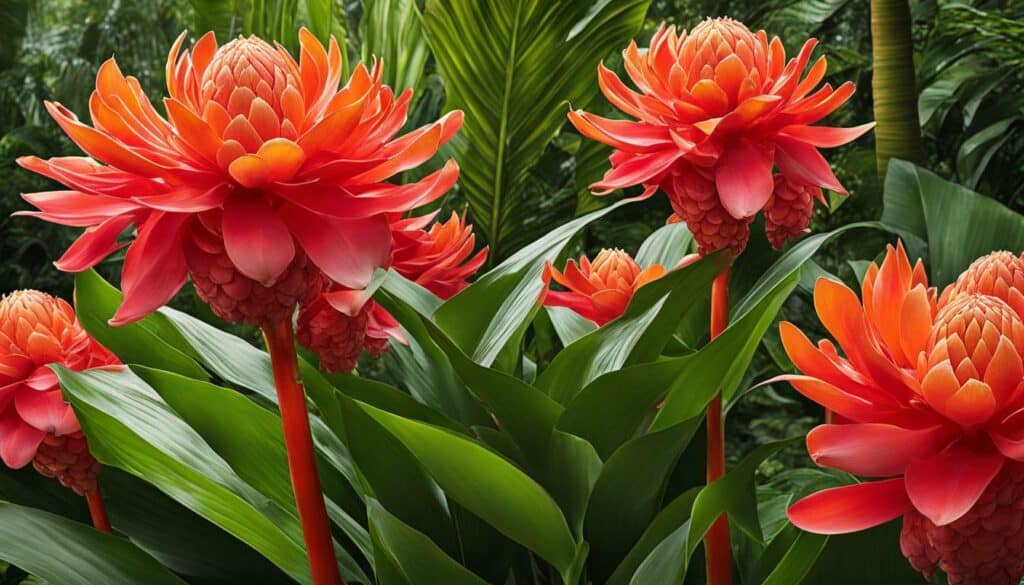
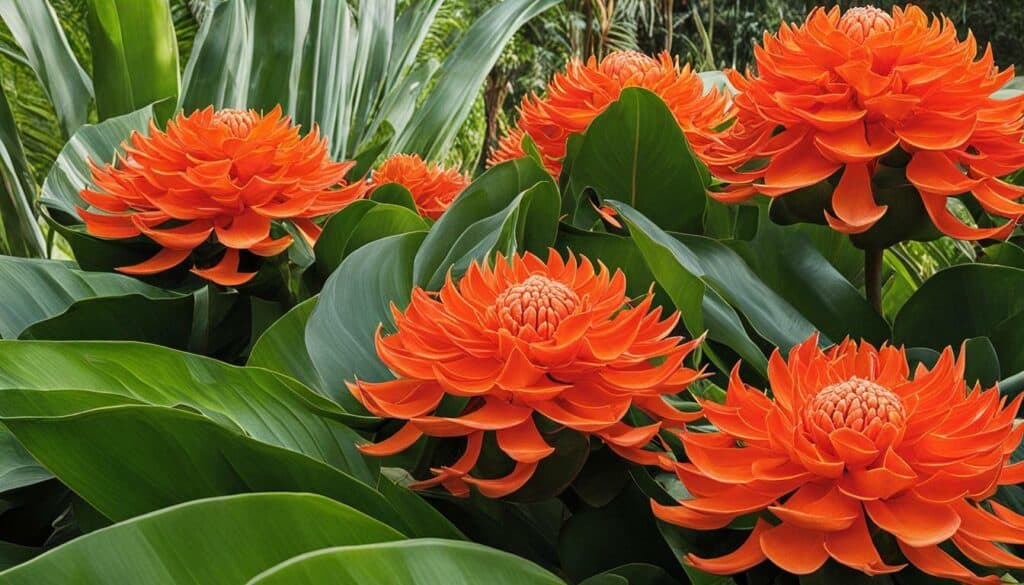
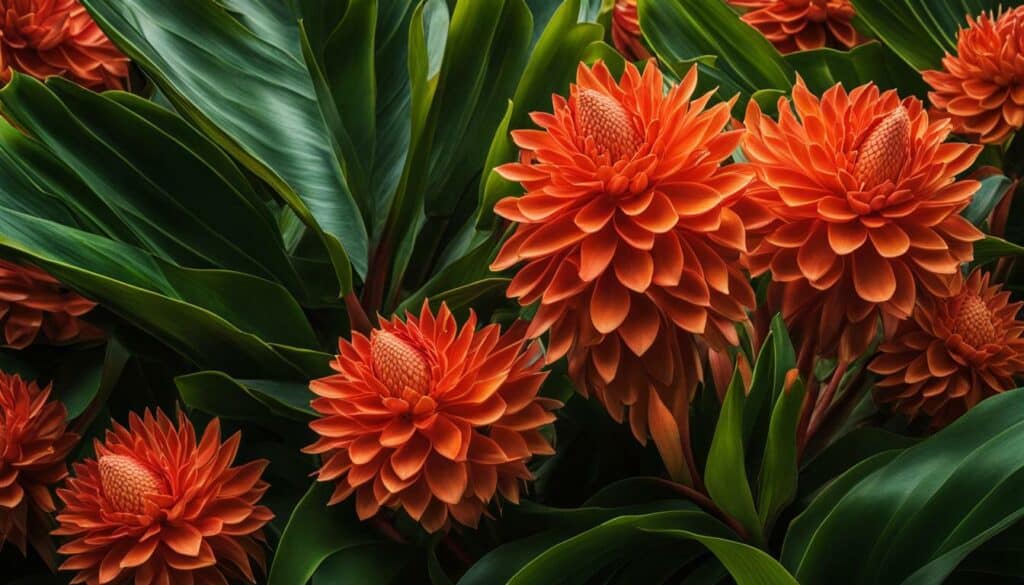
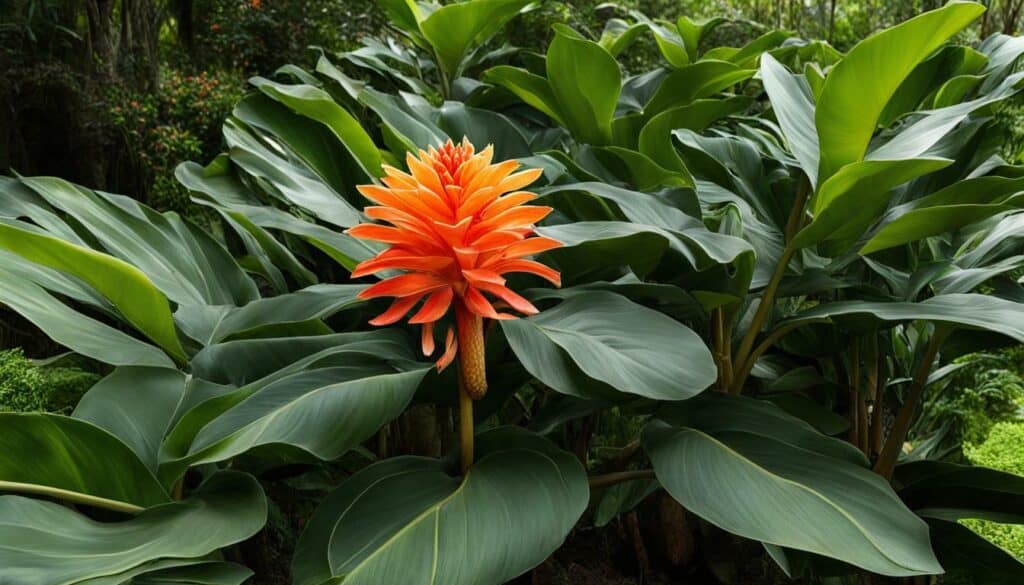
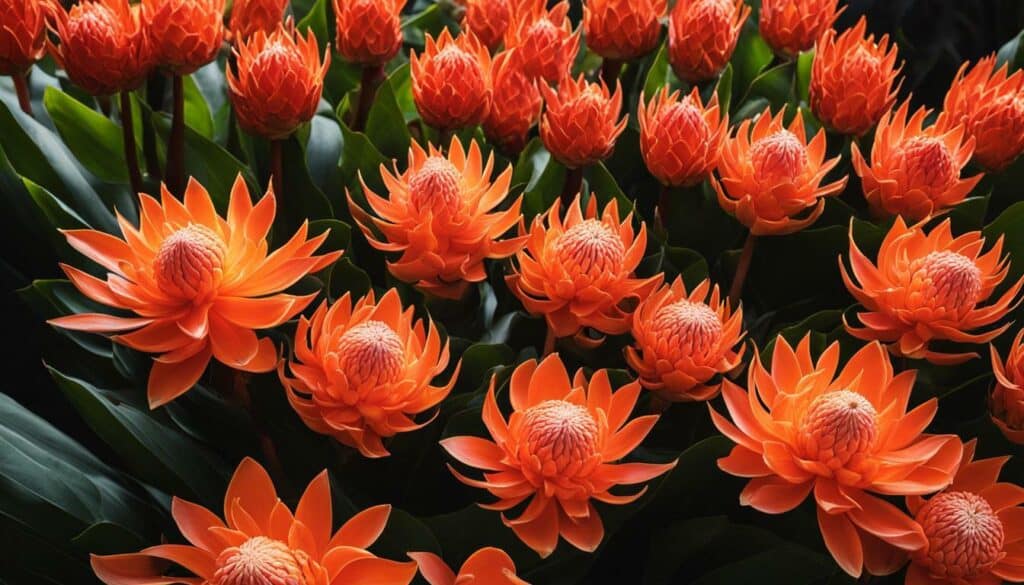

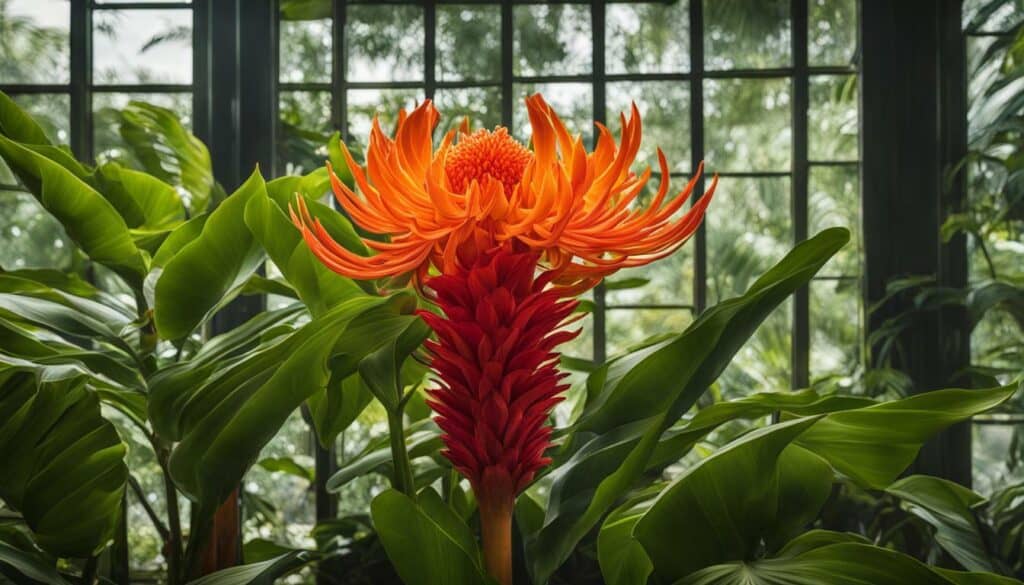




Leave a Reply